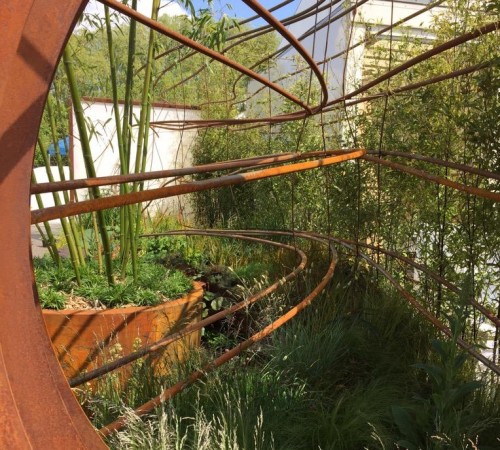
Gravitational gardening: the Dark Matter Garden at this year’s RHS Chelsea Flower Show. (Courtesy: National Schools’ Observatory)
By Hamish Johnston
Gardening is something that the British take very seriously and this week’s RHS Chelsea Flower Show is the pinnacle of that obsession. Indeed, it is so popular that it is covered live on television by the BBC. One highlight of the show is the garden competition, in which designers transform an empty plot into a dazzling garden in just 10 days. This year’s entries include the Dark Matter Garden, which “brings the mysteries of the universe to Chelsea”. That’s the claim of the designers of the garden (including several astronomers), who built it for the UK’s National Schools’ Observatory. The team says that its gold-medal-winning design includes “innovative structures and planting, and represents the effect of dark matter on light”.
What do atoms and black holes have in common? You might think “not much”, but in the video below, Asimina Arvanitaki of Canada’s Perimeter Institute explains why astronomers should be on the lookout for “gravitational atoms”. Just as atoms emit radiation at specific wavelengths, these colossal atoms would emit gravitons that in principle could be detected here on Earth (but I’m not sure how). There is more in the news release “A gravitational atom in the sky”.
This week’s science-related Twitter storm is swirling around the Caltech astronomer Sri Kulkarni, who described astronomers as “boys with toys” in a recent radio interview. This prompted female scientists around the world to tweet photos of themselves with their scientific “toys”. I’m not a big fan of “public shaming” campaigns, but this seems like a good-natured and positive response to Kulkarni’s unfortunate choice of words. You can see the photos online at #girlswithtoys.
Finally, I was really chuffed this week to discover that a story I wrote about condensed-matter physics was mentioned in the Daily Mail. I can’t say I’m an avid Mail reader, but I’m pleased that the UK’s most-read newspaper has published an article about high-temperature superconductivity: “New state of matter discovered“.
I like this:
” the Dark Matter Garden, which “brings the mysteries of the universe to Chelsea”.”
Chelsea is of course the centre of the universe – but from the perspective of every other centre of the universe (i.e. everywhere, in an infinite universe) the existence of a Chelsea Flower Show is probably a far greater mystery than even dark matter.
What a nice example of a gravitational atom in the sky, the solar system with its planets going around the Sun- the nucleus. However, this atom does not have much in common with the “quantum atom” controlle by the rules of QM via a wavefunction.
It is a sad day when Physics World wastes its readers time with a Chelsea Flower Show just because some hack in the show decided to include “dark matter” in the name of his entry.